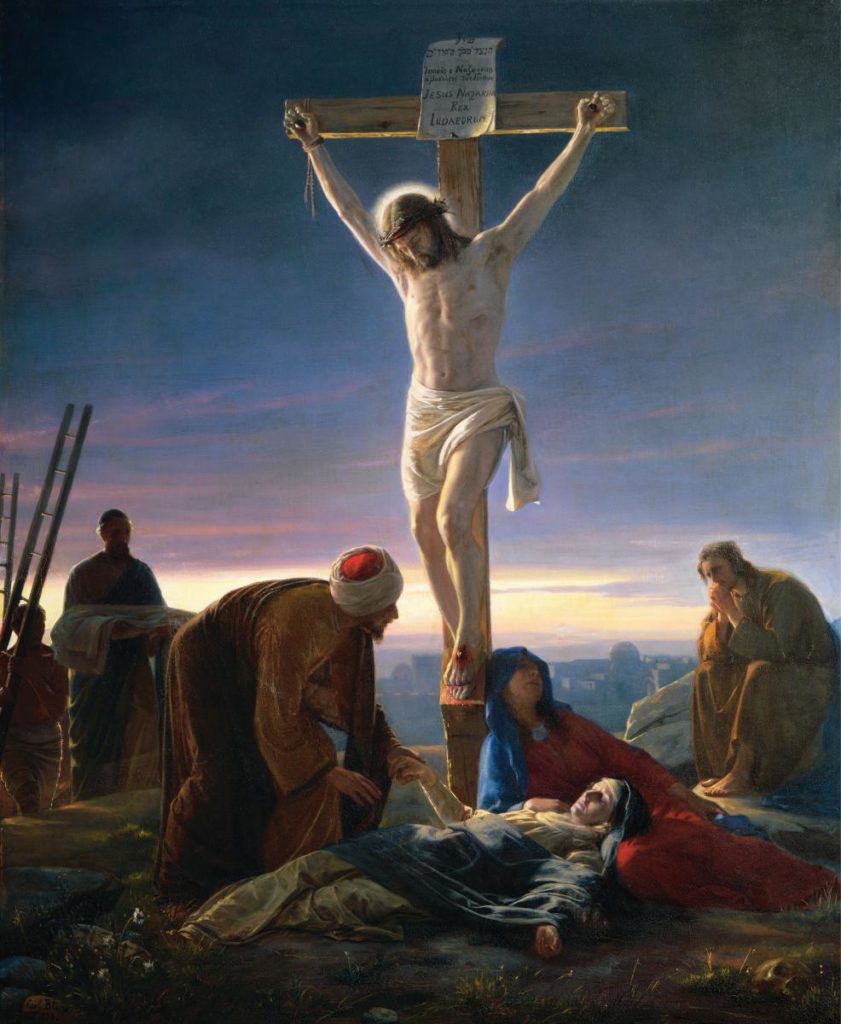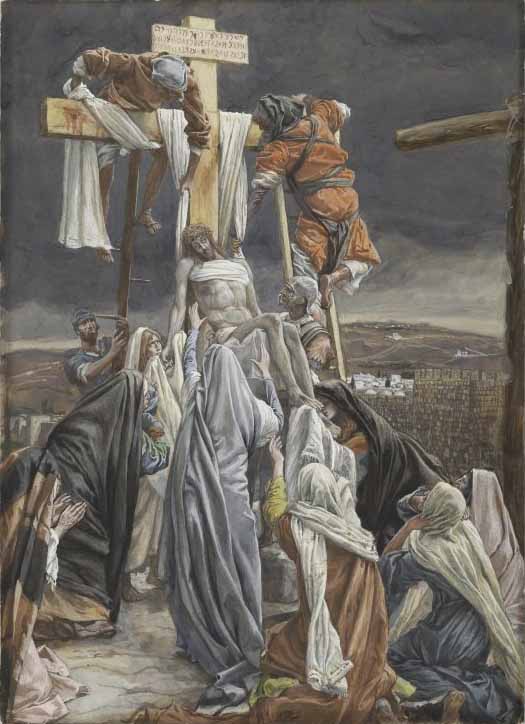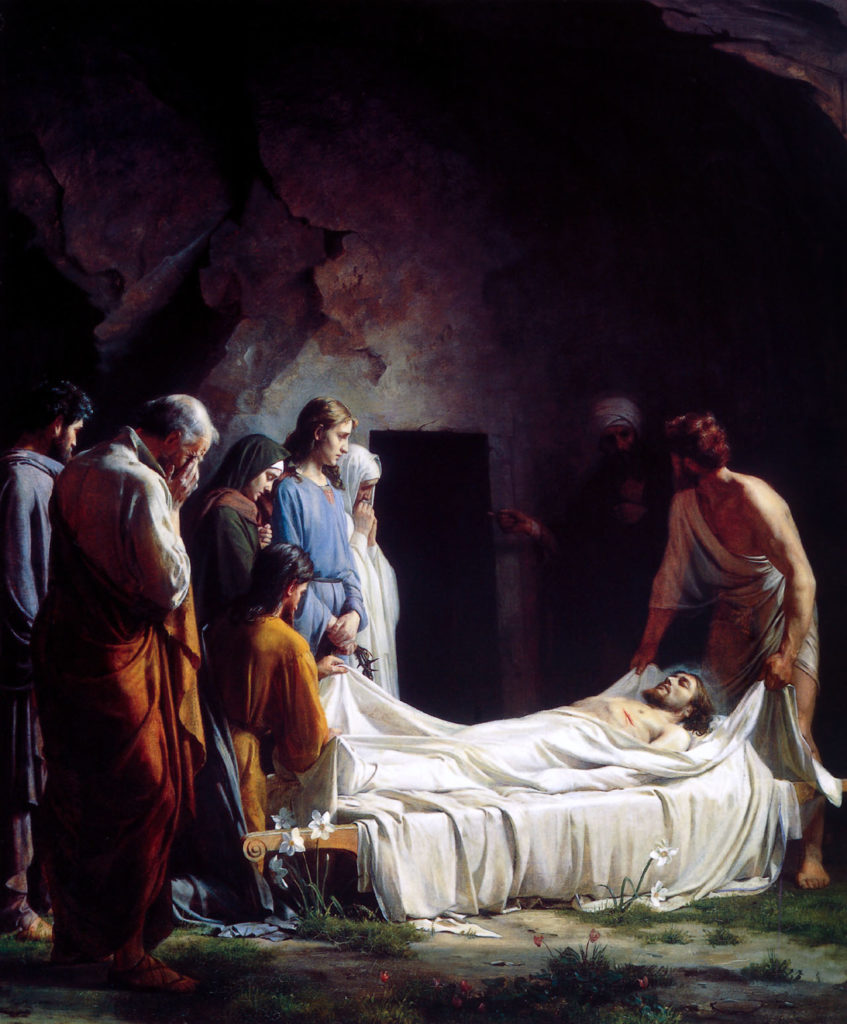Scripture readings: Isa.52:13-15, 52:1-12; Ps. 22; Heb.10:16-25; John 18:1-40, 19:1-42 Sermon by Ted Johnston (from John 19:16b-42) (drawing on commentary by Warren Wiersbe in The Bible Expository Commentary, Donald Guthrie in The New Bible Commentary, Michael Card in The Parable of Joy, and F.F. Bruce in The Gospel of John)
Jesus: Crucified, Dead and Buried
Here is a video from GCI Media that would make a good call to worship for this Good Friday service.On Vimeo at https://vimeo.com/257629415.
Introduction
[You might want to begin by leading the congregation in reciting the Apostle’s Creed.]
The Apostle’s Creed states it with simplicity: Jesus was “crucified, dead, and buried.” These three events in our Lord’s sacrifice are described in John 19:16–42. Here on Good Friday, the day on which Jesus died on the cross, we should understand these three great events not only historically (that they happened), but also theologically (why they happened).
1. Crucified (John 19:16b–27)
Pilate ordered Jesus’ crucifixion, handing him over to Roman soldiers who were responsible for executing the sentence. Jesus is now in their hands, yet, he is fully in control, carrying his own cross:
So the soldiers took charge of Jesus. Carrying his own cross, he went out to the place of the Skull (which in Aramaic is called Golgotha). There they crucified him, and with him two others—one on each side and Jesus in the middle. Pilate had a notice prepared and fastened to the cross. It read: Jesus of Nazareth, the King of the Jews. Many of the Jews read this sign, for the place where Jesus was crucified was near the city, and the sign was written in Aramaic, Latin and Greek. The chief priests of the Jews protested to Pilate, “Do not write ‘The King of the Jews,’ but that this man claimed to be king of the Jews.” Pilate answered, “What I have written, I have written.”
When the soldiers crucified Jesus, they took his clothes, dividing them into four shares, one for each of them, with the undergarment remaining. This garment was seamless, woven in one piece from top to bottom. “Let’s not tear it,” they said to one another. “Let’s decide by lot who will get it.” This happened that the scripture might be fulfilled that said, “They divided my clothes among them and cast lots for my garment.” So this is what the soldiers did.
Near the cross of Jesus stood his mother, his mother’s sister, Mary the wife of Clopas, and Mary Magdalene. When Jesus saw his mother there, and the disciple whom he loved standing nearby, he said to her, “Woman, here is your son,” and to the disciple, “Here is your mother.” From that time on, this disciple took her into his home. (John 19:16b–27)
The place of crucifixion was known as The Place of the Skull (Golgotha in Aramaic, Calvary in Latin). There Jesus was crucified between two criminals adding to his humiliation and fulfilling Isa. 53:12, “He was numbered with the transgressors.” He was treated like a common criminal—nailed to a cross and hung up for all to see. Because it was the Passover season, there were thousands of visitors in Jerusalem. The place of execution was on a main road just beyond the city walls where many people would pass. Jesus was a well-known figure, so his arrest and condemnation would be topics for discussion. It was natural for people to gather and watch the grim scene.

(public domain via Wikimedia Commons)
The crime of those being crucified was typically announced on a placard attached to their cross. Pilate ordered that Jesus’ placard read, “Jesus of Nazareth the king of the Jews.” The chief priests protested, but Pilate refused to change it. He knew this placard would insult and embarrass the Jewish religious establishment. The fact that it was written in Aramaic, Latin and Greek shows that our Lord was crucified in a place where many peoples and nations met. What Jesus did, he did for the whole world!
At most Roman crucifixions a centurion would be assigned with four soldiers to assist. Since Jesus was a popular rabbi with many followers, Pilate may have assigned more guards. It was the privilege of the soldiers to share whatever personal belongings the victims had; so they divided up Jesus’ clothing (clothing in those days was highly valuable). He would have had a turban, a pair of sandals, an undergarment (the seamless robe), an outer garment, and a girdle. The four men each took a piece of his clothing, and then they gambled for the seamless robe, thus fulfilling Ps. 22:18.
A group of women, along with the apostle John, stood near the cross. It took courage to stand there in the midst of such hatred and ridicule, but their being there must have encouraged Jesus. The first time we meet Jesus’ mother Mary in the Gospel of John, she is attending a wedding; now she is preparing for a burial. The hour had come—she was experiencing “the sword” that had been predicted years before (Luke 2:35).
Jesus assured Mary of his love, and gave his closest disciple to be her adopted son to care for her. Whether that moment John took Mary away from the scene and took her home, we do not know. We do know that he cared for her and that she was among the believers in the Upper Room as they awaited Pentecost (Acts 1:14). Even while he was performing the great work of redemption, Jesus was faithful to his responsibilities as a son.
2. Dead (John 19:28–30)
Later, knowing that everything had now been finished, and so that Scripture would be fulfilled, Jesus said, “I am thirsty.” A jar of wine vinegar was there, so they soaked a sponge in it, put the sponge on a stalk of the hyssop plant, and lifted it to Jesus’ lips. When he had received the drink, Jesus said, “It is finished.” With that, he bowed his head and gave up his spirit. (John 19:28–30)
Our Lord knew what was going on—he was fully in control as he obeyed the Father’s will. He had refused to drink the pain-deadening wine that was always offered to those about to be crucified (Matt. 27:34). In order to fulfill the Scriptures (probably Ps. 69:21), he said, “I thirst.” He was enduring real physical suffering in a real human body (that he retains, now glorified). He had just emerged from three hours of darkness when he felt the full weight of human sin (Matt. 27:45–49). There were physical reasons for his thirst (Ps. 22:15), but there were also spiritual reasons (Ps. 42:1–2).
One of the soldiers took pity on Jesus and moistened his lips with the cheap vinegar wine the soldiers drank to refresh themselves. His feet were perhaps three or four feet from the ground, so it would be easy for the man to put a sponge at the end of a reed and give Jesus a drink. This action also fulfilled prophecy (Ps. 69:3).
The drink of vinegar did not fully quench Jesus’ thirst, but it did enable him to utter that shout of triumph, in a loud voice, “It is finished,” which in Greek is tetelestai, meaning it is finished or accomplished. All Scripture that was due to be accomplished in Jesus’ passion had now been accomplished: the entire purpose for which the Father had sent the Son into the world was now assured of fulfillment, and since that purpose included the salvation of the world, salvation and eternal life were henceforth freely available to all.

(public domain via Wikimedia Commons)
Jesus’ death is a central theme in the Gospel of John and John uses several pictures to describe and define it, thus making it clear that Jesus’ death was not an accident—it was a divine appointment. He was not murdered in one sense—he willingly gave his life for us. His death was an atonement, not just an example. He actually accomplished the work of redemption on the cross. Also, Jesus’ death was voluntary: he willingly dismissed his spirit (John 19:30; and note John 10:17–18). He “gave himself” for us (Gal. 2:20).
3. Buried (John 19:31–42)
Now it was the day of Preparation, and the next day was to be a special Sabbath. Because the Jewish leaders did not want the bodies left on the crosses during the Sabbath, they asked Pilate to have the legs broken and the bodies taken down. The soldiers therefore came and broke the legs of the first man who had been crucified with Jesus, and then those of the other. But when they came to Jesus and found that he was already dead, they did not break his legs. Instead, one of the soldiers pierced Jesus’ side with a spear, bringing a sudden flow of blood and water.
The man who saw it has given testimony, and his testimony is true. He knows that he tells the truth, and he testifies so that you also may believe. These things happened so that the scripture would be fulfilled: “Not one of his bones will be broken,” and, as another scripture says, “They will look on the one they have pierced.”
Later, Joseph of Arimathea asked Pilate for the body of Jesus. Now Joseph was a disciple of Jesus, but secretly because he feared the Jewish leaders. With Pilate’s permission, he came and took the body away. He was accompanied by Nicodemus, the man who earlier had visited Jesus at night. Nicodemus brought a mixture of myrrh and aloes, about seventy-five pounds. Taking Jesus’ body, the two of them wrapped it, with the spices, in strips of linen. This was in accordance with Jewish burial customs. At the place where Jesus was crucified, there was a garden, and in the garden a new tomb, in which no one had ever been laid. Because it was the Jewish day of Preparation and since the tomb was nearby, they laid Jesus there. (John 19:31–42)
Two groups of people were involved in our Lord’s burial: Roman soldiers (John 19:31–37), and Jewish believers (John 19:38–42). It was not unusual for victims to remain on the cross in a lingering death, so the Jewish religious leaders did all they could to hasten the death of Jesus and the two thieves so that they would die before the Sabbath day began (late Friday afternoon). However, our Lord was in control; and he dismissed his spirit at “the ninth hour,” which was 3 P.M. (Matt. 27:45–50).
It is remarkable that the Roman soldiers did not do what they were commanded to do—break the victims’ legs—but they did do what they were not supposed to do—pierce the Savior’s side! In both matters, they fulfilled the word of God! The bones of the Passover lamb were not to be broken (Ex. 12:46), so our Lord’s bones were protected. His side was to be pierced (Zech. 12:10), so that was done by one of the soldiers.
John saw special significance in the blood and water that came from the wound in Jesus’ side. For one thing, it proved that Jesus had a real body (1 John 1:1–4) and had experienced a real death. By the time John wrote this book, there were false teachers in the church claiming Jesus did not have a truly human body. God made it clear that Jesus is who he claimed to be, God come in the flesh. John makes it clear that the water and blood should encourage us to believe that Jesus is indeed the Christ (John 20:31).
When the soldiers were through with their gruesome work, Jesus’ friends took over. God provided two high-ranking men to prepare Jesus’ body for burial and to place it in a proper tomb. Had Joseph of Arimathea and Nicodemus not been there, it is likely that Jesus’ body would have been thrown into a ditch somewhere and perhaps burned (as likely happened to the two theives crucified with Jesus). If the friends of a victim appeared, the Romans were happy to give them the body to get it off their hands.
Joseph of Arimathea was rich, a prominent member of the Jewish council, a good and righteous man who had not consented to what the council did, a member of the believing minority of Jews who were praying for Messiah to come, and a follower of Jesus. It was he who asked for the body of Jesus and, with his friend Nicodemus, gave our Savior a decent burial. Matthew, Luke, and John all tell us that the tomb Joseph provided Jesus was new. John informs us that Joseph was a secret disciple for fear of the Jews. From the human standpoint, Joseph kept “under cover” because he feared the Jews; but from the divine standpoint, he was being protected so he could be available to bury the body of Jesus.
We met Nicodemus already in John 3. Though he started off with confusion at night, he ended up with open confession in the daylight. Nicodemus thus came out of the dark and into the light and, with Joseph, was not ashamed to publicly identify with Jesus. When the two men touched his dead body, they defiled themselves and could not participate in Passover. But, no matter, they had found the Lamb of God!

(public domain via Wikimedia Commons)
It is evident that Joseph and Nicodemus had carefully planned their activities at Calvary. Given that it was the Passover, they would have been unable at the last minute to both secure a tomb and purchase 65 pounds of spices. No sooner had Jesus died than Joseph went to Pilate and received permission to take the body. Nicodemus stayed at the cross to make sure nothing happened to Jesus’ body.
The men worked quickly to finish their work before sundown and the start of the Sabbath. They could not give Jesus’ body the full ministry of washing and anointing that was traditional, but they did the best they could. Mary of Bethany had already anointed Jesus’ body for burial (John 12:1–8). Some of the other women watched the two men minister to Jesus, and they witnessed his burial (Matt. 27:61). They planned to return after the Sabbath was over and complete the burial procedures (Luke 23:55–24:1).
All of these followers of Jesus boldly identified with Jesus at a time when he seemed like a failure and his cause hopelessly defeated. As far as we know, of all of Jesus’ inner circle of 12 disciples, only John was with Jesus at the cross.
Conclusion
Jesus our Lord: crucified, dead and now buried. Our Lord now rested in his tomb, awaiting the dawn of the “new creation” (2 Cor. 5:17) on Easter Sunday morning. See you then!
Note: Though in many Christian traditions, communion is not offered on Good Friday, if your congregation did not share the Lord’s Supper on Maundy Thursday, you may wish to have communion following this sermon on Good Friday. Here are notes (by Jonathan Stepp) to guide you:
On this day during Holy Week, we have good cause to speak of the bread and wine in terms of Jesus’ death on the cross. As Scripture says, the bread and wine “proclaim the Lord’s death” (1 Cor. 11:26). The reason Jesus suffered and died was not to appease an angry Father who would forgive us only if someone was tortured to death. Rather, the crucifixion is the circumcision of our hearts—the cutting away of our sinful human nature (Col. 2:11)—and the victory of Jesus over Satan, by which we are set free from death (Heb. 2:14). Notice especially the verse from Hebrews: “By his death he set free those who all their lives were in slavery to the fear of death.”
Jesus’ death changed human nature, not the Father’s nature. It was not the Father’s attitude that needed to be changed by Jesus’ death—it was fallen, sinful human nature that needed to be changed. This is why the bread and wine are symbols of what took place on the cross.
By sharing in human nature through his body and blood, the Son shared in the human condition and gave us a share in his divine condition. When Jesus died, we all died with him (2 Cor. 5:14). Communion on Good Friday is our celebration of how fallen human nature died once, for all time, in the death of Jesus. The bread and wine are symbols of the human nature that was crucified in Christ on the cross.



We know human nature is still alive and quite sick inside us. The death of human nature at the cross must mean the death of its consequences which is death itself. The removal of condemnation. The limitless depth and width of God’s grace.